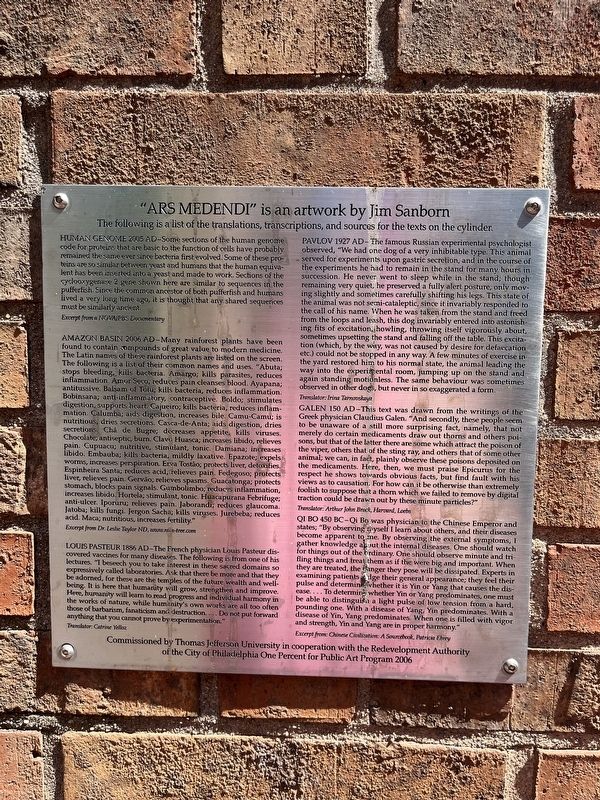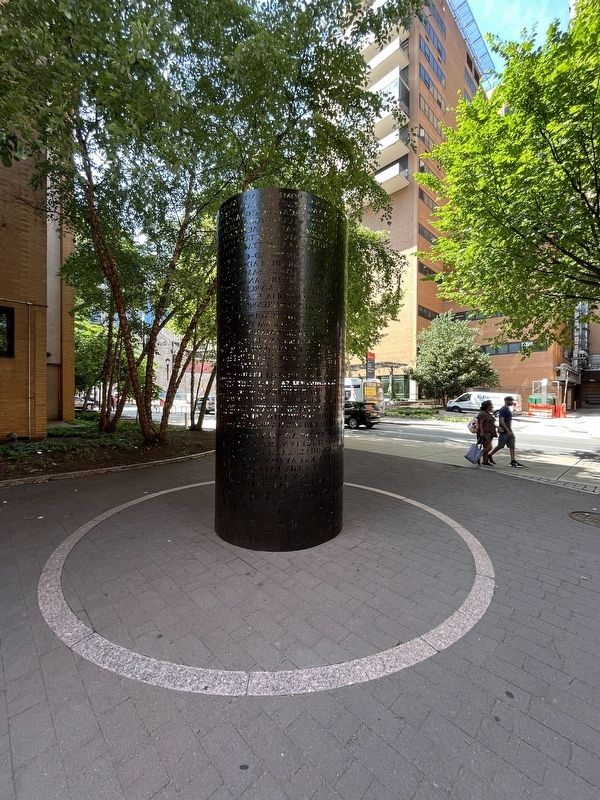Washington Square West in Philadelphia in Philadelphia County, Pennsylvania — The American Northeast (Mid-Atlantic)
"Ars Medendi" is an artwork by Jim Sanborn
Inscription.
Human Genome 2005 AD - Some sections of the human genome code for proteins that are basic to the function of the cells have probably remained the same ever since bacteria first evolved. Some of these proteins are so similar between yeast and humans that the human equivalent has been inserted into a yeast and made to work. Sections of the oxygenation 2 gene shown here are similar to sequences in the pufferfish. Since the common ancestor to both pufferfish and humans lived a very long time ago, it is thought that any shared sequences must be similarly ancient.
Excerpt from a NOVA/PBS Documentary
Amazon Basin 2006 AD - Many rainforest plants have been found to contain compounds of great value to modern medicine. The Latin names of these rainforest plants are listed on the screen. The following is a list of their common names and uses. "Abuta; stops bleeding, kills bacteria. Amargo; kills parasites, reduces inflammation. Amor Seco; reduces pain, cleanses blood. Ayapana; antitussive. Balsam of Tolu; kills bacteria, reduces inflammation. Bobinsana; anti-inflammatory, contraceptive. Boldo; stimulates digestion, supports heart. Cajueiro; kills bacteria, reduces inflammation. Columba; aids digestion, increases bile. Camu-Camu; is nutritious, dries secretions. Casca-de-Anta; aids digestion, dries secretions. Chá de Bugre; decreases appetite, kills viruses. Chocolate; antiseptic, burn. Clavo Huasca; increases libido, relieves pain. Capuacu; nutritive, stimuland, tonic. Damiana; increases libido. Embauba; kills bacteria, mildly laxative. Epazote; expels worms, increases perspiration. Erva Tostâo; protects liver, detoxifies. Espinheira Santa; reduces acid, relieves pain. Fedegoso; protects liver, relieves pain. Gervão; relieves spasms. Guacatonga; protects stomach, blocks pain signals. Gumbolimbo; reduces inflammation, increases libido. Hortela; stimulant, tonic. Huacapurana Febrifuge; anti-ulcer. Iporuru; relieves pain. Jaborandi; reduces glaucoma. Jatoba; kills fungi. Jergon Sacha; kills viruses. Jurebeba; reduces acid. Maca; nutritious, increases fertility."
Excerpt from Dr. Leslie Taylor ND, www.rain-tree.com
Louis Pasteur 1886 AD - The French physician Louis Pasteur discovered vaccines for many diseases. The following is from one of his lectures. "I beseech you to take interest in these sacred domains so expressly called laboratories. Ask that there be more and that they be adorned, for these are the temples of the future wealth and well-being. It is here that humanity will grow, strengthen and improve.
Here, humanity will learn to read progress and individual harmony in the works of nature, while humanity's own works are all too often those of barbarism, fanaticism and destruction.... Do not put forward anything that you cannot prove by experimentation."
Translator: Catrine Yelloz
Pavlov 1927 AD - The famous Russian experimental psychologist observed, "We had one dog of a very inhabitable type. This animal served for experiments upon gastric secretion, and in the course of the experiments he had to remain in the stand for many hours in succession. He never went to sleep while in the stand; though remaining very quiet, he preserved a fully alert posture, only moving slightly and sometimes carefully shifting his legs. This state of the animal was not semi-cataleptic, since it invariably responded to the call of his name. When he was taken from the stand and freed from the loops of the leash, this dog invariably entered into astonishing fits of excitation, howling, throwing itself vigorously about, sometimes upsetting the stand and falling off the table. This excitation (which, by the way, was not caused by desire for defaecation etc.) could not be stopped in any way. A few minutes of exercise in the yard restored him to his normal state, the animal leading the way into the experimental room, jumping up on the stand and again standing motionless. The same behaviour was sometimes observed in other dogs, but never so exaggerated a form.
Galen 150 AD - This text was drawn from the writings of the Greek physician Claudius Galen. "And secondly, these people seem to be unaware of a still more surprising fact, namely, that not merely do certain medicaments draw out thorns and others poisons, but that of the latter there are some which attract the poison of the viper, others that of the sting ray, and others that of some other animal; we can, in fact, plainly observe these poisons deposited on the medicaments. Here, then, we must praise Epicurus for the respect he shows towards obvious facts, but find fault with his views as to causation. For how can it be otherwise than extremely foolish to suppose that a thorn which we failed to remove by digital traction could be drawn out by these minute particles?"
Translator: Arthur Brock, Harvard, Loebs
Qi Bo 450 BC - Qi Bo was physician to the Chinese Emperor and states; "By observing myself I learn about others, and their diseases become apparent to me. By observing the external symptoms, I gather knowledge about the internal diseases. one should watch for things out of the ordinary. One should observe minute and trifling things and treat them as if the were big and important. When they are treated, the danger they pose will be dissipated. Experts in examining patients judge their general appearance; they feel their pulse and determine whether it is Yin or Yang that causes the disease.... To determine whether Yin or Yang predominates, one must be able to distinguish a light pulse of low tension from a hard, pounding one. With a disease of Yang, Yin predominates. With a disease of Yin, Yang predominates. When one is filled with vigor and strength, Yin and Yang are in proper harmony."
Excerpt from Chinese Civilization: A Sourcebook, Patricia Ebrey
Erected 2006 by Thomas Jefferson University in cooperation with the Redevelopment Authority of the City of Philadelphia One Percent for Public Art Program.
Topics. This historical marker is listed in these topic lists: Arts, Letters, Music • Science & Medicine. A significant historical year for this entry is 2005.
Location. 39° 56.907′ N, 75° 9.507′ W. Marker is in Philadelphia, Pennsylvania, in Philadelphia County. It is in Washington Square West. Marker is on Walnut Street (County Road 3006) just east of South 11th Street, on the left when traveling west. Touch for map. Marker is at or near this postal address: 1025 Walnut Street, Philadelphia PA 19107, United States of America. Touch for directions.
Other nearby markers. At least 8 other markers are within walking distance of this marker. Samuel D. Gross (within shouting distance of this marker); a different marker also named "Ars Medendi" is an artwork by Jim Sanborn (about 300 feet away, measured in a direct line); On this block in 1930 (about 400 feet away); McClellan House (about 500 feet away); On this block in 1899 (about 600 feet away); The S·S·White · Dental Manufacturing Company (about 600 feet away); Philadelphia Electric Company (about 600 feet away); 1122 Locust Street (about 700 feet away). Touch for a list and map of all markers in Philadelphia.
Credits. This page was last revised on February 1, 2024. It was originally submitted on July 4, 2023, by Devry Becker Jones of Washington, District of Columbia. This page has been viewed 83 times since then and 23 times this year. Photos: 1, 2, 3. submitted on July 4, 2023, by Devry Becker Jones of Washington, District of Columbia.


